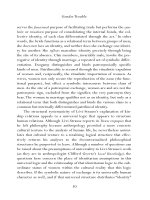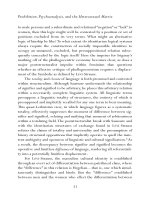GENDER TROUBLE 98
Bạn đang xem bản rút gọn của tài liệu. Xem và tải ngay bản đầy đủ của tài liệu tại đây (20.54 KB, 1 trang )
Prohibition, Psychoanalysis, and the Heterosexual Matrix
the statement partially quoted above: “These remarks should be qualified by going back to the function of the mask [which is] to dominate
the identifications through which refusals of love are resolved,” and if
female homosexuality is understood as a consequence of a disappointment “as observation shows,” then this disappointment must appear,
and appear clearly, in order to be observed. If Lacan presumes that
female homosexuality issues from a disappointed heterosexuality, as
observation is said to show, could it not be equally clear to the observer that heterosexuality issues from a disappointed homosexuality? Is it
the mask of the female homosexual that is “observed,” and if so, what
clearly readable expression gives evidence of that “disappointment”
and that “orientation” as well as the displacement of desire by the (idealized) demand for love? Lacan is perhaps suggesting that what is clear
to observation is the desexualized status of the lesbian, the incorporation of a refusal that appears as the absence of desire.20 But we can
understand this conclusion to be the necessary result of a heterosexualized and masculine observational point of view that takes lesbian sexuality to be a refusal of sexuality per se only because sexuality is
presumed to be heterosexual, and the observer, here constructed as
the heterosexual male, is clearly being refused. Indeed, is this account
not the consequence of a refusal that disappoints the observer, and
whose disappointment, disavowed and projected, is made into the
essential character of the women who effectively refuse him?
In a characteristic gliding over pronomial locations, Lacan fails to
make clear who refuses whom. As readers, we are meant, however, to
understand that this free-floating “refusal” is linked in a significant way
to the mask. If every refusal is, finally, a loyalty to some other bond in
the present or the past, refusal is simultaneously preservation as well.
The mask thus conceals this loss, but preserves (and negates) this
loss through its concealment. The mask has a double function which
is the double function of melancholy. The mask is taken on through
the process of incorporation which is a way of inscribing and then
wearing a melancholic identification in and on the body; in effect, it is
63









